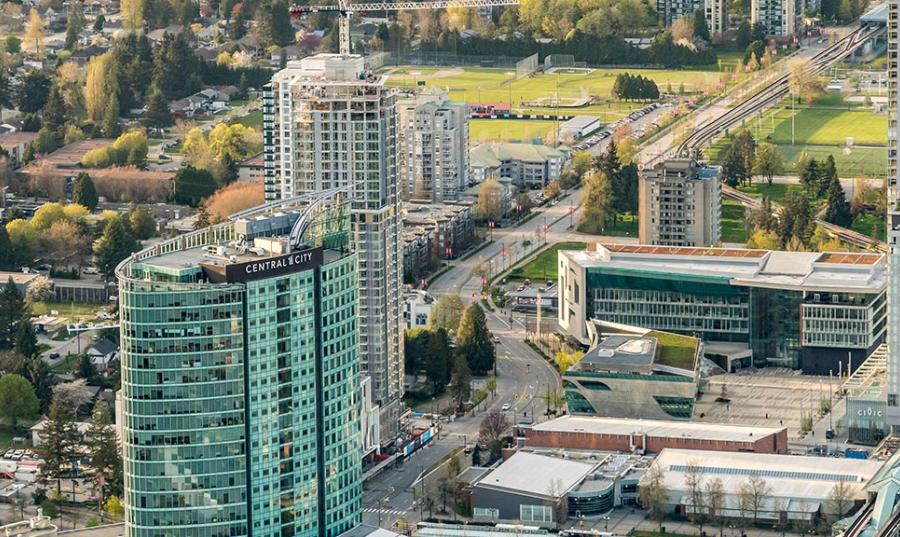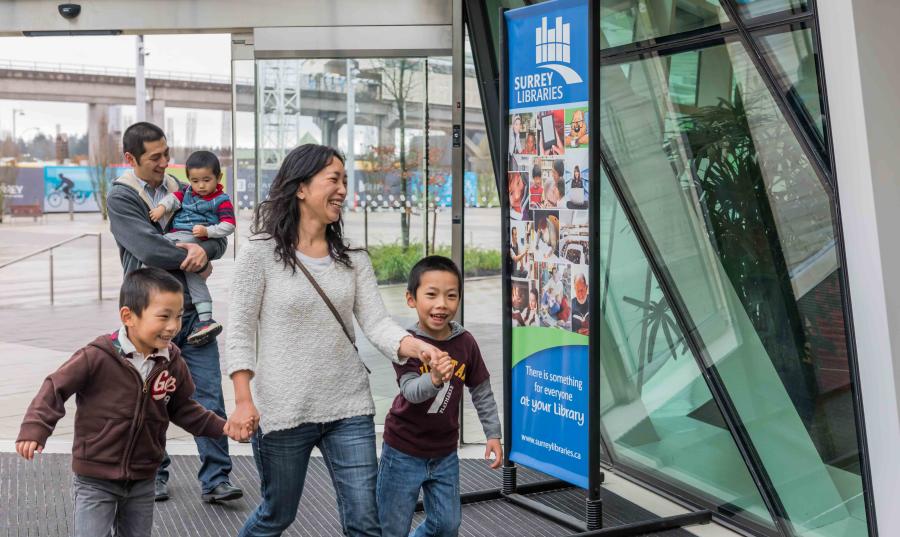Interview with City of Surrey’s Assistant Fire Chief Shelly Morris & Canadian Manufacturers & Exporters Association’s Andrew Wynn-Williams
The last few years have seen us experiencing a fair share of emergencies, from the COVID-19 pandemic to flood-inducing atmospheric rivers and wildfires. In Surrey EconomIQ Insights Podcast Episode 04, we gain unique insights on how businesses can participate in building community resiliency for these crises. Hear from Shelley Morris, Assistant Fire Chief with the City of Surrey for her local emergency preparedness perspective, as well as Andrew Wynn-Williams, Divisional Vice President of BC for the Canadian Manufacturers and Exporters Association, who provides insights from BC manufacturing businesses.
Key experiences learned from pandemic
Shelley: We’ve been planning for the Big One earthquake for years and knew there were many different risks in the area, with some being common to the whole geographic area. We talk about collaborating all the time and sharing our skills and resources, but when the pandemic came, we had a difficult time doing that. We all had our different goals and objectives and different ways of achieving them, so we weren't able to come together in the way that we should have when this was affecting all of us. So, we did notice that our supply chains and our transportation routes, especially during the flood, created a big problem. We originally thought there would be panic buying and we tell people to be personally prepared for up to a week, but it became a self-fulfilling prophecy. While supply chains slowed down, we had difficulty getting them and, on top of that, everybody started panic buying. This exacerbated a situation that combined the risk we had with people's behaviours on top of it.
Andrew: The issue that manufacturers ran into was not being quite sure of the opportunity that they could help address. Yes, we can make masks, but what sort of masks? What are the components that go into those masks? We quickly found out that barrier for making N95 masks, the high-end ones, was blown plastic. A lot of manufacturers couldn’t get the blown plastics, so many companies pivoted into making non-medical masks. However, a few stuck with it and got the right equipment and materials and have been very successful in producing masks. The issue now is that if the government goes back to making all the purchases overseas now that the crisis is over, we won't have the domestic supply chain of masks, which we now view as critical.
Are we more prepared now?
Andrew: From the perspective of the manufacturer, we think that we've nailed a lot of it, as far as the pandemic is concerned. The key will be sustaining and maintaining it. We've been using masks as a proxy for all kinds of different products and PPE, but one of the ones I think of is that there's a company in Surrey that developed a really effective test kit system - it's a plastics company. That test kit system is top of the line and it's not much more expensive than other products. This test kit system can also be used for seasonal flu testing and other kinds of testing, but unless the Provincial Health Services Authority, who does a lot of government purchasing for those kinds of products, actually makes a point of buying the Canadian product, they won't be able to maintain that supply chain here. We use masks as a proxy, but it goes beyond masks. There's a bunch of things that we deem as critical for these kinds of situations and if we want to be able to ramp up and product them quickly, then we need to make sure that the supply chain is viable in the near term as well.
Flexibility of Standards
Stephen: During the pandemic, we saw standards being a barrier to entry to the market. If you made a gown, it needed to be certified by some agency because it became a union issues. If you made a mask, it needed to go through a lot of testing and certification and that became an issue. Do you think that during emergencies we need to be a bit more flexible because that was one of the biggest barriers? And I get that there's this public safety issue too.
Shelley: That's the really difficult thing to get around here - it's the public safety issue. If we reduce those barriers, what sort of products do we have in the end? Certain ones don’t need a lot of restrictions - if you want to build a plexiglass barrier, it just needs to be a barrier and that made a lot of sense. But when you're talking about masks and you have first responders going in and it's protecting each other from the virus, you have to maintain a high standard there - there's not way of getting around that. I think that there's definitely some areas where we can reduce some of those limitations and allow the production to flow quicker and then there's some areas you can't. Somebody's got to make that decision.
Andrew: I had an interesting conversation with a mask manufacturer who said that the standards for Canadian-made N95 masks are higher than the standards that Japanese companies or Chinese companies need to meed for a K95 that they're importing. It's actually higher even than the American FDA N95 standard. This is fine if we maintain that standard for importing masks, but if we're not maintaining that same standard for imported masks, why do we have it?
Shelley: Then you have to look at the standards and say, when you're having a supply issue, can I lower them? Are my standards too high? If you can maintain the safety while lowering the standards, then there's a huge benefit to lowering it at that time.
Sustaining Emergency Capabilities
Shelley: Right off the top of my head, I'm thinking inventory. I know that a lot of us took a look of our inventory and a long time ago. We understood the need to hold inventory and then nothing happened. We didn't have a pandemic, we didn't have a need for the inventory, so when they became out of date, we didn't replace them as we should. I think what we learned is that we need to hold an inventory. It's critical to keep going in the beginning stages of any emergency until we can get the supply chain going again.
Andrew: From the manufacturing side, we would like to see governments in some way identify which elements of emergency supplies that they think are critical to maintain domestic production capabilities. Once we've identified those, they can amend their purchasing policies to support those local domestic producers and so we’re not stuck in a situation like we were at the start of the pandemic where we had no domestic capability for producing those kinds of products and we were having to import them from China where everyone else was also trying to import them from. And in the near term, it may be more expensive to produce some of that in Canada, but not outrageously so and it's a sacrifice that's worth making.
Shelley: You have to put that investment where you need it and it will pay out in the end. And I think for a lot of people, the inventory that I spoke of is difficult to maintain and it's not a viable solution for them. But maybe having a domestic source to get it from is your next best way to get there.
Andrew: And one way to build that inventory is to buy domestically. Make sure you get that domestic purchasing going over the longer period and it will be great if we get another pandemic we'll be prepared.
Emergency supplies inventory – is it realistic and what types of supplies?
Shelley: We take an all-hazards approach to emergency management. We understand a lot of things can happen, but if we can have a uniform approach to it, we're way better off. So having said that, we can carry supplies that we know we need to carry out our essential services, which can save lives and mitigate the impact. While we can’t predict everything we're going to need in the moment, we can have a good understanding of it. Like the masks and medical supplies, there are certain things that you can definitely say that we are going to need this in any emergency. The first thing we want to do is save lives, so we look at our most critical function and ask, “How are going to carry that out? What sort of supplies is that going to take?” Being able to pinpoint it all is going to be impossible to do, but having a diversification in your own local economy that can resource it for you - that's going to be your best bet. Collaboration is also important - knowing your partners - the private industries, your partners in local government, all the non-profit organizations. They all have massive capabilities and skills and when they come together, we can do anything. We just have to form that network beforehand.
When it comes to the Big One (earthquake), it's going to be all about moving debris and moving supplies. It will be about getting food, water, and medical supplies and getting it to the people that need them. It will be mostly about a loss of transportation routes, which is why we talk about needing to be able to locally source so then anything we need. And locally means probably not travelling over bridges. We need to have those distribution centres in a common place where people can go get it because it's going to be unlikely we can move around. It's going to be difficult to find out what we need to manufacture until we know, but definitely first aid supplies, food, and basic medications. The things people need to survive that they can't get access to - those are the things that we will need right away and the storage space for that.
If there was an emergency and we needed the supplies, a lot of it will be airlifted from other places. A lot of support, but building local resiliency for a lot of stuff so that we can be a bit more self-sufficient.
We’ll have a lot of support from the Provincial and Federal Government, but when we look at emergency planning, we always think about the worst case scenario. If we can't travel the bridges, the Provincial and Federal Government will do anything they can to put the resources where it's needed, but if we can be as self-sufficient as we possibly can, then we're doing everybody a favour. Then, they can move those resources to other places that are more in need. The best we can do is to be good where we are.
How can businesses better prepare?
Shelley: It all comes down to business continuity. How can you stay on your feet and how can you continue to function despite disruption? We're all going digital now - so what's going to stop you from being able to produce what you're producing or pay your employees?
Andrew: I know of a company that recently had a ransomware attack and they only missed about an hour of shift because they had a paper backup system that they were able to switch to and then get their other emergency measures in place. That's a great example of a business that's very successfully dealt with a crisis that was just them. But I'm sure that if something happened like the Big One and all the networks went down, that same company would be able to keep operating because they have those backup paper systems in place.
Shelley: If one point can take down your whole business, that's where you need to look at being resilient.
How resilient are our manufacturers right now?
Andrew: The quality varies from manufacturer to manufacturer. Some are better prepared than others, but if you wanted to look at something that is more global issue, it is the unavoidable issue of supply chain. We have very international supply chains coming in and we are a part of international supply chains going out. A lot of people look at it and their biggest concern is that our members can't something imported in, but we are also part of international supply chains. Anything that disrupts stuff coming in is also disrupting stuff going out.
Most manufacturers have done pretty well in managing. They have gone away from just-in-time inventory to having larger inventories of the supplies they need. A lot of them have started to diversify their supply chains so they can get it from more locations, but there's still going to be impact because there are certain things that are just unavoidable - like 30% of the steel coming out of Russia and Ukraine globally. That's going to have an impact. You can diversify your supply chain all you want, but when you take that out of world system, that's a problem.
There are some things that you're never going to be able to supply locally - that's just a fact of life. There are some things that we can diversify, if we make an effort, and have more resilient local supply chains, but the reality is that it's a mix. Some things we're going to be able to respond, and some we aren’t. The real key is to make sure we understand what drives success for us in manufacturing and how we can manufacture successfully and support those things. That will automatically support the supply chain for those manufacturers as well. For example, we have a lot of steel fabricators in British Columbia and most of them are part of other supply chains that are supplying for other industries.
Do you feel optimistic that BC is prepared for emergencies?
Shelley: I think we're realizing that emergencies like this are an ongoing thing over these last two years. We're talking about the atmospheric rain event, the heat dome, the wildfires - we're now normalizing emergencies in a way. Where other countries have already dealt with this through seismic upgrades to all their building and schools, we’ve started to do that here, but I think there's an urgency to all this now. We're now putting the funding into the mitigation and the preparation that maybe we should have put more into before, but it's hard to motivate and get that money to go into a direction that we haven't seen a need to. We knew that there was a vulnerability to it, but now we see that this is real - this is not going away. We're now at a point of, "What's next?" We're having some good conversations about what needs to be done and finally things are getting done. That's exciting in this world where every time we go through something, we want to build back better. It's something we're always talking about in the emergency world, but now we have the money to back it up. We're going to build back way better than we did year after year because it isn't going away.








